
Concept explainers
(a)
Interpretation:
The product of the given reaction is to be predicted.
Concept introduction:
The mechanism for epoxides under neutral or basic conditions consists of an SN2 step followed by a proton transfer reaction. Under neutral or basic conditions, a nucleophile attacks an epoxide at the least substituted carbon atom (less sterically hindered) of the ring from the side opposite to the oxygen atom. Under acidic conditions, the first step is the protonation of C−O bond. This generates a partial positive charge on the carbon atoms in the epoxide. In the second step, a nucleophile attacks the most substituted carbon atom in the epoxide from the side opposite to the C−O bond.
Answer to Problem 10.53P
The product of the given reaction is:

Explanation of Solution
The given reaction is:

When the given epoxide is treated with sodium azide (basic conditions), the azide ion in sodium azide acts as a nucleophile and attacks the less substituted carbon atom (highlighted in red) of the epoxide. Due to this, the highly strained epoxide ring opens and the azide gets attached to the less substituted carbon atom. In the presence of a solvent such as water, the negatively charged oxygen atom is protonated resulting in the final product. The product of the reaction when the given epoxide is treated with sodium azide is as below:

Epoxides can undergo nucleophilic substitution reactions under neutral or basic conditions in which the nucleophile attacks the least substituted carbon atom in the epoxide.
(b)
Interpretation:
The product of the given reaction is to be predicted.
Concept introduction:
Epoxides react readily under neutral, basic, or acidic conditions. Epoxides can undergo SN2 reactions in neutral or basic reaction conditions so as to relieve the ring strain, and this compensates for the poor leaving group ability of alkoxides (RO−).
The mechanism for the epoxides under neutral or basic conditions consists of an SN2 step followed by a proton transfer reaction. Under neutral or basic conditions, a nucleophile attacks an epoxide at the least substituted carbon atom (less sterically hindered) of the ring from the side opposite to the oxygen atom. Under acidic conditions, the first step is the protonation of C−O bond. This generates a partial positive charge on the carbon atoms in the epoxide. In the second step, a nucleophile attacks at the most substituted carbon atom in the epoxide from the side opposite to the C−O bond.
Answer to Problem 10.53P
The product of the given reaction is:
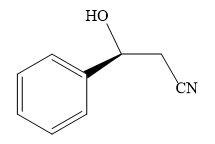
Explanation of Solution
The given reaction is:

The given reaction conditions are basic as the potassium cyanide is a weak base and nucleophile.
When the given epoxide is treated with potassium cyanide (neutral conditions), the cyanide ion acts as a nucleophile and attacks the least substituted carbon atom of the epoxide. Due to this, the highly strained epoxide ring opens and the cyanide ion gets attached to the carbon. In the presence of a solvent such as ethanediol, the negatively charged oxygen atom is protonated resulting in the final product. The product of the reaction when the given epoxide is treated with sodium azide is as below:

Epoxides can undergo nucleophilic substitution reactions under neutral or basic conditions in which the nucleophile attacks the least substituted carbon atom in the epoxide.
(c)
Interpretation:
The product of the given reaction is to be predicted.
Concept introduction:
Epoxides react readily under neutral, basic, or acidic conditions. Epoxides can undergo SN2 reactions in neutral or basic reaction conditions so as to relieve the ring strain and this compensates for the poor leaving group ability of alkoxides (RO−).
Under acidic conditions, the first step is the protonation of C−O bond. This generates a partial positive charge on the carbon atoms in the epoxide. In the second step, a nucleophile attacks the most substituted carbon atom in the epoxide from the side opposite to the C−O bond.
Answer to Problem 10.53P
The product of the given reaction is:
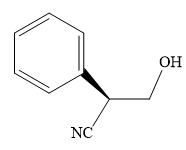
Explanation of Solution
The given reaction is:

The given reaction conditions are acidic as hydrogen cyanide is a weak acid.
When the given epoxide is treated with hydrogen cyanide (acidic conditions), the first step is the protonation of the epoxide oxygen atom. Due to this, a partial positive charge is generated on both carbon atoms in the epoxide. Out of the two carbon atoms, the one that is most substituted would be able to stabilize the partially developed charge, and thus, in the second step, the nucleophile, cyanide ion attacks the most substituted carbon atom from the side opposite to the C−O bond. This is the ring opening step. In the last step, the acid, HCN protonates the negatively charged oxygen atom to yield the final product. The product of the reaction when the given epoxide is treated with hydrogen cyanide is as below:
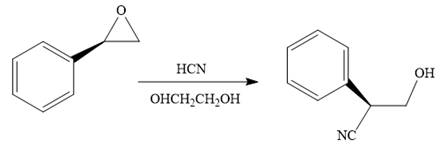
Epoxides can undergo nucleophilic substitution reactions under acidic conditions in which the nucleophile attacks the most substituted carbon atom in the epoxide.
(d)
Interpretation:
The product of the given reaction is to be predicted.
Concept introduction:
Epoxides react readily under neutral, basic, or acidic conditions. Epoxides can undergo SN2 reactions in neutral or basic reaction conditions so as to relieve the ring strain, and this compensates for the poor leaving group ability of alkoxides (RO−).
The mechanism for the epoxides under neutral or basic conditions consists of an SN2 step followed by a proton transfer reaction. Under neutral or basic conditions, a nucleophile attacks an epoxide at the least substituted carbon atom (less sterically hindered) of the ring from the side opposite to the oxygen atom. Under acidic conditions, the first step is the protonation of C−O bond. This generates a partial positive charge on the carbon atoms in the epoxide. In the second step, a nucleophile attacks the most substituted carbon atom in the epoxide from the side opposite to the C−O bond.
Answer to Problem 10.53P
The product of the given reaction is:
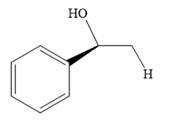
Explanation of Solution
The given reaction is:
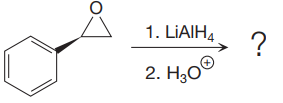
The given reaction conditions are basic as lithium aluminum hydride is a strong base.
LiAlH4 is a hydride nucleophile and can open the epoxide ring via an SN2 reaction. The H- generated from LiAlH4 attacks the least substituted carbon atom in the epoxide. In the next proton transfer step, H3O+, which is a strong acid, protonates the negatively charged oxygen in the epoxide to yield the final product. The product of the reaction when the given epoxide is treated with LiAlH4 is as below:

Epoxides can undergo nucleophilic substitution reactions under neutral or basic conditions in which the nucleophile attacks the least substituted carbon atom in the epoxide.
(e)
Interpretation:
The product of the given reaction is to be predicted.
Concept introduction:
Epoxides react readily under neutral, basic, or acidic conditions. Epoxides can undergo SN2 reactions in neutral or basic reaction conditions so as to relieve the ring strain and this compensates for the poor leaving group ability of alkoxides (RO−).
Under acidic conditions, the first step is the protonation the C−O bond. This generates a partial positive charge on the carbon atoms in the epoxide. In the second step, a nucleophile attacks the most substituted carbon atom in the epoxide from the side opposite to the C−O bond.
Answer to Problem 10.53P
The product of the given reaction is:
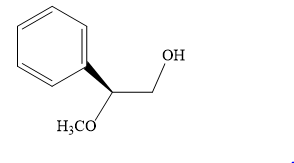
Explanation of Solution
The given reaction is:
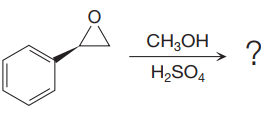
The given reaction conditions are methanol in sulfuric acid. Sulfuric acid is a strong acid. When it is treated with methanol, it will produce protonated methanol which is a strongest known acid. When the given epoxide is treated with protonated methanol, (highly acidic conditions), the first step is the protonation of the oxygen atom in the epoxide. Due to this, a partial positive charge is generated on both the carbon atoms in the epoxide. Out of the two carbon atoms, the one that is most substituted would be able to stabilize the partially developed positive charge. Thus, in the second step, the nucleophile, methoxide ion attacks the most substituted carbon atom from the side opposite to the protonated C−O bond. This is the ring opening step. In the last step, the acid, sulfuric acid protonates the negatively charged oxygen atom to yield the final product. The product of the reaction when the given epoxide is treated with methanol in sulfuric acid is as below:
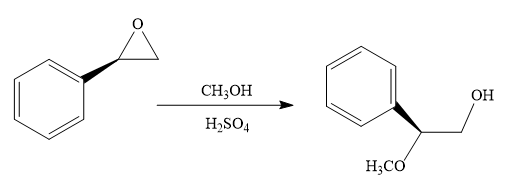
Epoxides can undergo nucleophilic substitution reactions under acidic conditions in which the nucleophile attacks on the most substituted carbon atom in the epoxide.
(f)
Interpretation:
The product of the given reaction is to be predicted.
Concept introduction:
Epoxides react readily under neutral, basic, or acidic conditions. Epoxides can undergo SN2 reactions in neutral or basic reaction conditions so as to relieve the ring strain, and this compensates for the poor leaving group ability of alkoxides (RO−).
The mechanism for the epoxides under neutral or basic conditions consists of an SN2 step followed by a proton transfer reaction. Under neutral or basic conditions, a nucleophile attacks an epoxide at the least substituted carbon atom (less sterically hindered) of the ring from the side opposite to the oxygen atom. Under acidic conditions, the first step is the protonation of C−O bond. This generates a partial positive charge on the carbon atoms in the epoxide. In the second step, a nucleophile attacks the most substituted carbon atom in the epoxide from the side opposite to the C−O bond.
Answer to Problem 10.53P
The product of the given reaction is:
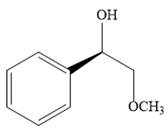
Explanation of Solution
The given reaction is:

When the given epoxide is treated with sodium methoxide in methanol (basic conditions), the methoxide ion acts as a nucleophile and attacks the least substituted carbon atom of the epoxide. Due to this, the highly strained epoxide ring opens and the methoxide ion gets attached to the least substituted carbon atom. The product of the reaction when the given epoxide is treated with sodium methoxide in methanol is as below:

Epoxides can undergo nucleophilic substitution reactions under neutral or basic conditions in which the nucleophile attacks the least substituted carbon atom in the epoxide.
(g)
Interpretation:
The product of the given reaction is to be predicted.
Concept introduction:
Epoxides react readily under neutral, basic, or acidic conditions. Epoxides can undergo SN2 reactions in neutral or basic reaction conditions so as to relieve the ring strain and this compensates for the poor leaving group ability of alkoxides (RO−).
The mechanism for the epoxides under neutral or basic conditions consists of an SN2 step followed by a proton transfer reaction. Under neutral or basic conditions, a nucleophile attacks an epoxide at the least substituted carbon atom (less sterically hindered) of the ring, from the side opposite to the oxygen atom. Under acidic conditions, the first step is the protonation of C−O bond. This generates a partial positive charge on the carbon atoms in the epoxide. In the second step, a nucleophile attacks the most substituted carbon atom in the epoxide from the side opposite to the C−O bond.
Answer to Problem 10.53P
The product of the given reaction is:
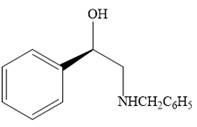
Explanation of Solution
The given reaction is:

When the given epoxide is treated with benzyl

Epoxides can undergo nucleophilic substitution reactions under neutral or basic conditions in which the nucleophile attacks on the least substituted carbon atom in the epoxide.
(h)
Interpretation:
The product of the given reaction is to be predicted.
Concept introduction:
Epoxides react readily under neutral, basic, or acidic conditions. Epoxides can undergo SN2 reactions in neutral or basic reaction conditions so as to relieve the ring strain, and this compensates for the poor leaving group ability of alkoxides (RO−).
The mechanism for the epoxides under neutral or basic conditions consists of an SN2 step followed by a proton transfer reaction. Under neutral or basic conditions, a nucleophile attacks an epoxide at the least substituted carbon atom (less sterically hindered) of the ring, from the side opposite to the oxygen atom. Under acidic conditions, the first step is the protonation of the C−O bond. This generates a partial positive charge on the carbon atoms in the epoxide. In the second step, a nucleophile attacks the most substituted carbon atom in the epoxide from the side opposite to the C−O bond.
Answer to Problem 10.53P
The product of the given reaction is:
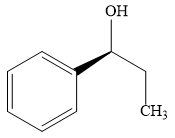
Explanation of Solution
The given reaction is:

Methyl lithium is an inorganic methylating agent. When the given epoxide is treated with methyl lithium (basic conditions), the methyl anion acts as a nucleophile and attacks the least substituted carbon atom of the epoxide. Due to this, the highly strained epoxide ring opens. In the second step, acidic workup is important so as to protonate the negatively charged oxygen atom.
The product of the reaction when the given epoxide is treated with methyl lithium in the acidic workup is as below:

Epoxides can undergo nucleophilic substitution reactions under neutral or basic conditions in which the nucleophile attacks the least substituted carbon atom in the epoxide.
Want to see more full solutions like this?
Chapter 10 Solutions
Organic Chemistry: Principles and Mechanisms (Second Edition)
- Show how to convert ethyl benzene to (a) 2,5-dichlorobenzoic acid and (b) 2,4-dichlorobenzoic acid.arrow_forwardHelp me solve this problem. Thank you in advance.arrow_forward22.7 Predict the monoalkylated products of the following reactions with benzene. (a) AlCl3 Ya (b) AlCl3 (c) H3PO4 (d) 22.8 Think-Pair-Share AICI3 The reaction below is a common electrophilic aromatic substitution. SO3 H₂SO4 SO₂H (a) Draw the reaction mechanism for this reaction using HSO,+ as the electrophile. (b) Sketch the reaction coordinate diagram, where the product is lower in energy than the starting reactant. (c) Which step in the reaction mechanism is highest in energy? Explain. (d) Which of the following reaction conditions could be used in an electrophilic aro- matic substitution with benzene to provide substituted phenyl derivatives? (i) AICI3 HNO3 H₂SO4 K2Cr2O7 (iii) H₂SO4 (iv) H₂PO₁arrow_forward
- Is an acid-base reaction the only type of reaction that would cause leavening products to rise?arrow_forwardHelp me understand this! Thank you in advance.arrow_forward22.22 For each compound, indicate which group on the ring is more strongly activating and then draw a structural formula of the major product formed by nitration of the compound. Br CHO (a) CH3 (b) (c) CHO CH3 SO₂H (d) ☑ OCHS NO₂ (e) (f) CO₂H NHCOCH3 NHCOCH, (h) CHS 22.23 The following molecules each contain two aromatic rings. (b) 000-100- H3C (a) (c) Which ring in each undergoes electrophilic aromatic substitution more readily? Draw the major product formed on nitration.arrow_forward
- V Consider this step in a radical reaction: Br: ? What type of step is this? Check all that apply. Draw the products of the step on the right-hand side of the drawing area below. If more than one set of products is possible, draw any set. Also, draw the mechanism arrows on the left-hand side of the drawing area to show how this happens. ⚫ionization termination initialization neutralization none of the abc Explanation Check 80 Ο F3 F1 F2 2 F4 01 % do5 $ 94 #3 X 5 C MacBook Air 25 F5 F6 66 ©2025 ˇ F7 29 & 7 8arrow_forwardShow how to convert ethyl benzene to (a) 2,5-dichlorobenzoic acid and (b) 2,4-dichlorobenzoic acid.arrow_forwardno aiarrow_forward
- Polymers may be composed of thousands of monomers. Draw three repeat units (trimer) of the polymer formed in this reaction. Assume there are hydrogen atoms there are hydrogen atoms on the two ends of the trimer. Ignore inorganic byproducts.arrow_forwardDraw a tetramer if this alternating copolymer pleasearrow_forwardDraw the monomers required to synthesize this condensation polymer.arrow_forward
 Organic Chemistry: A Guided InquiryChemistryISBN:9780618974122Author:Andrei StraumanisPublisher:Cengage Learning
Organic Chemistry: A Guided InquiryChemistryISBN:9780618974122Author:Andrei StraumanisPublisher:Cengage Learning EBK A SMALL SCALE APPROACH TO ORGANIC LChemistryISBN:9781305446021Author:LampmanPublisher:CENGAGE LEARNING - CONSIGNMENT
EBK A SMALL SCALE APPROACH TO ORGANIC LChemistryISBN:9781305446021Author:LampmanPublisher:CENGAGE LEARNING - CONSIGNMENT

